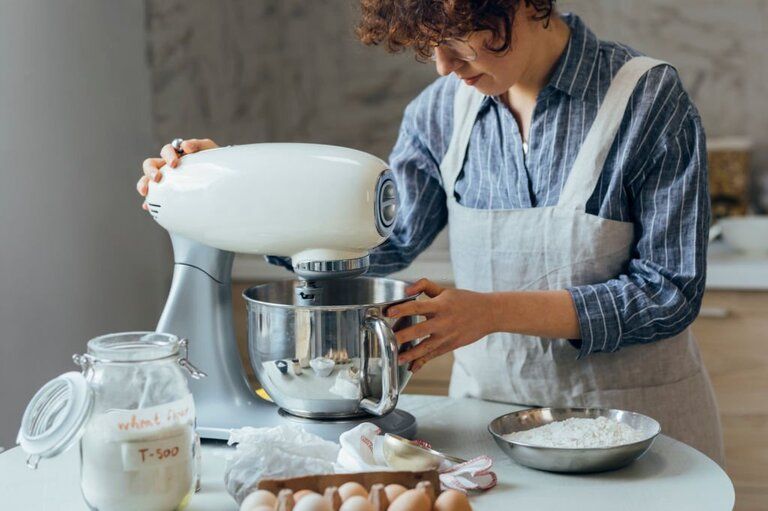There's no doubt that the stand mixer is far superior to the portable type, but this convenience comes at a cost. In contrast, the stand form is more useful, especially if supplementary attachments are offered. Purchasing a stand mixer may involve a little investment, and with many sizes, features, and capabilities, you may be confused. And this is a gadget you don't want to have to replace anytime soon. These suggestions might assist you in making the best purchasing selection. Here are some steps how to choose stand mixer:
1. How to Choose Stand Mixer

The first consideration is how you want to utilize the mixer. If you bake for a big family or social occasions, or if you produce many loaves of bread every week, you'll need a strong motor and a large capacity bowl - 600 watts minimum and a 6 quart or greater capacity bowl. It is critical to base your selection on expertise. If your demands are lower and you get a big mixer, it will be difficult to operate for little amounts. If your demands are high and you get a smaller machine, you will need to divide your recipes and cook them in portions. And here are some steps how to choose stand mixer:
Weight and dimensions

Anyone who bakes cookies all week or has to feed a hungry family would appreciate the big mixer. If you use a bigger stand mixer, keep in mind that a strong motor is required to adequately knead the dough. To prevent causing havoc on your countertop, your new mixer should be rather weighty.
If you only cook for two people or have a tiny kitchen with limited counter space, a smaller model is a must. The regular size bowl holds between 4.5 and 5.5 liters of batter, which is plenty for most handmade cakes and pastries. Smaller versions are easy to carry from cupboard to countertop, which is essential if you don't intend to use the mixer frequently.
Larger sizes vary from 6 to 8 liters, making them excellent for all you baking heroes out there!
Power

A common rule of thumb is to choose the most powerful mixer within your price range. The larger the wattage, the more powerful the motor, which allows you to combine tougher dough securely.
Price

Stand mixers are available at different price points, with the top of the best costing hundreds of dollars. The cost of these machines is determined by elements such as brand name, capacity, and features, as well as any unique attachments. The good news is that a high-quality stand mixer can be purchased for under $100. Some are less expensive; nevertheless, these mixers are less durable and may break down with repeated severe usage.
A good stand mixer is an investment for your kitchen, so it may be worth the extra money.
Accessories and features

You should evaluate the available features on the models you're considering, from speed settings to attachments. For the greatest value, choose a stand mixer with numerous speed settings and whisks, a dough hook, and a paddle.
Every stand mixer on the market comes with a plethora of attachments to help you get the most out of this amazing device.
Storage

Will your mixer have a prominent place on the kitchen counter, or will it have to fit into a cupboard? Mixers are often huge, bulky, and heavy to store, so bear this in mind if you want to do so.
Most versions now come in a variety of colors and styles, so if you have the room on your bench, you'll probably want to put it on show.
Splash guard

A splash guard will keep components from pouring out of the mixing bowl while you're mixing, saving you from an unanticipated dust cloud of flour or a fountain of liquid disaster.
The guard should preferably be attached to the motor head so that when the motor head is lifted, it pulls away from the bowl. This makes it easy to reach the mixture because you wouldn't have to remove the guard every time you wanted to scrape it down.
Speed options

A variety of speed settings is required. Six speeds are generally plenty. Look for the following:
- Bowl made of stainless steel
A stainless steel mixing bowl is exceptionally sturdy and should outlast the mixer. If you break a glass or plastic bowl, it may be difficult to replace it. Also, seek for a bowl with a handle to make pouring mixes easier.
- Button for release
A release button for the beaters will keep your hands clean of sticky materials.
- Timer
This isn't a typical feature, but it will come in handy if you have recipes that specify the amount of mixing time.
2. How to Clean Stand Mixer

A stand mixer is a definite kitchen need for layer cakes that stand tall and fluffy buttercream frostings. Follow these cleaning techniques for a stand mixer to keep it in good operating order for decades.
Here are the essentials for cleaning the bowl and accessories of a stand mixer:
- Remove the attachment from your stand mixer and set it in a dish filled with warm soapy water to soak while you finish making your recipe. (These are some of our fave mixer-required recipes!)
- Place the attachment and bowl in the dishwasher after thoroughly cleaning them. For speciality accessories, follow the manufacturer's instructions—some attachments are not dishwasher-safe. If you want to hand-wash, use hot, soapy water.
- Before storing your bowl and accessories, completely dry them. This will keep water stains at bay and mildew at bay.
When using a stand mixer, more than just the bowl and attachments become gunky. After each usage, wipe off the body and head of the stand mixer with a damp dish towel or microfiber cloth (a cheap purchase that will really improve your cleaning game!). The nooks and crannies of the mixer's body are prone to collecting flour and other tiny particulates, and a fast wipe down prevents build-up.
Never clean your mixer with spray cleaners or soaking damp cloths. Water, even in little amounts, can harm the motor within the mixer's head.
Before storing your bowl and accessories, completely dry them. This will keep water stains at bay and mildew at bay.
Clean the stand mixer's vents once a month with a cotton swab or a clean toothbrush. These vents give airflow to the motor and are necessary for your mixer to work optimally. If a dry swab or brush isn't enough to remove the dust, soak it in warm water with a pinch of baking soda before cleaning. If the buildup has solidified, a toothpick can be used to remove it.
Remember that these vents have direct access to the mixer's engine, so make sure no water gets in. The cotton swab or toothbrush should be dampened, not drenched, in the water-baking soda combination.
Conclusion
A food mixer is a versatile weapon in your culinary armory, a handy kitchen device designed to eliminate most of the physical labor involved in food preparation. A food mixer is a device that rotates beaters inside a mixing bowl using a gear-driven mechanism. Many food mixers have the strength and convenient attachments to do a variety of culinary jobs, such as blending components for a cake batter, whipping whipped cream for said cake, and even kneading dough for fresh bread. While it may be a catch-all name for the handy compact gadgets, 'food mixers' can refer to stand mixers, hand mixers, and bench top kitchen mixers, all of which work differently. Hope those steps of choosing a stand mixer help you to get a fit one.













